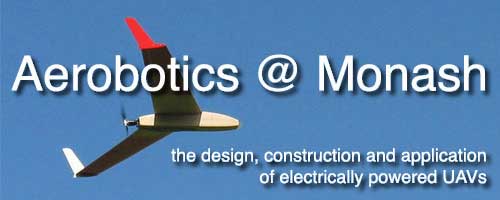Construction:
Fuselage is a simple box structure. Balsa sides
and ply formers reinforced with glass cloth inside and out where
required.
Motor is soft mounted with rubber machine mounts.
All control systems are mounted behind the wing trailing edge,
this leaves room for the payload and motor battery to placed to
obtain the correct CG.
Wings are white styrene foam covered with 2 layers
of 2 & 3 ounce glass cloth. Wing tubes for joiner rod are
carbon fibre, the wing joining rod is also carbon fibre. Elevon
servos are mounted in the wing.
P16025
Specifications:
Span: 160 cm
Chord: 25cm
Length: 106 cm
Wing Section: EMX07
Controls: Elevons
Weight range: 2.2 to 3.2 Kg - depends on motor battery and payload
configuration
Motor: Hacker B40 21L Geared drive (Maxon 5.2:1), 16 x 13 Aeronaut
Cam Carbon Prop
Motor Battery: 6 series x 4 parallel eTec 1200 Lithium Polymer
cells
Control System: JR3810 Tx, JR649 Rx, 2 x Hitec wing servos
Launch system: Hand launch able.
Flight Duration: 60 to 90 minutes (@ 60kph cruise) depends on
battery & payload.
Speed: Stall 30Kph, Cruise 60Kph, Max 135Kph
Auto Pilot: Monash Infrared System (under development)
Flight termination: Parachute
Payload: Pentax Optio S 3.2 mp with Video down link
Construction:
Fuselage is a simple box structure. Balsa sides
and ply formers reinforced with glass cloth inside and out where
required.
Motor is soft mounted with rubber machine mounts.
All control systems are mounted behind the wing trailing edge,
this leaves room for the payload and motor battery to placed to
obtain the CG.
Wings are white styrene foam cover with Obechi
veneer. Wing tubes for joiner rod are carbon fibre, the wing joining
rod is also carbon fibre. Elevon servos are mounted in the wing.
Plank Genesis
The plank aircraft have their genesis with an EMX07
wing cut by Ray circa 2000 at John Bird's instigation which lanquished
for a few years. It was finally assembled into our first prototype
plank (Cornflake video)
in mid-2002 by Greg Egan and is still intact. A second prototype
also by Greg (Weetie video)
with an MH60 was constructed one year later and is also still
intact. The designs are quite unusual for planks in that they
have distinctive long tail boom yielding excellent low
speed stability. The stall behaviour and general robustness of
planks when crashed into cargo nets, or just generally into the
scenery, is self evident.
 AEROBOTICS ARCHIVE
AEROBOTICS ARCHIVE AEROBOTICS ARCHIVE
AEROBOTICS ARCHIVE